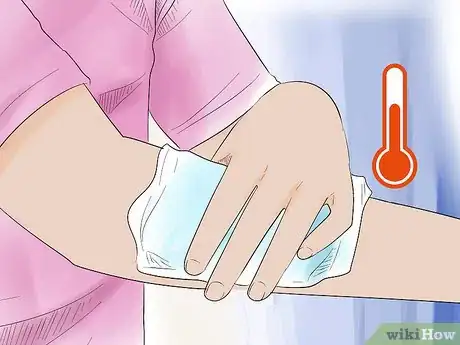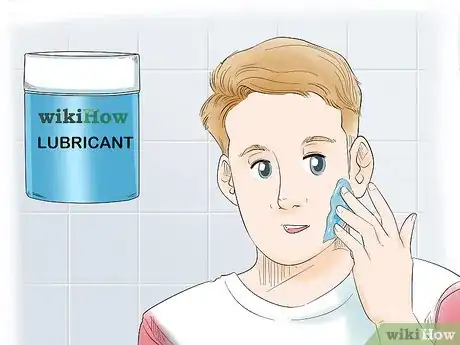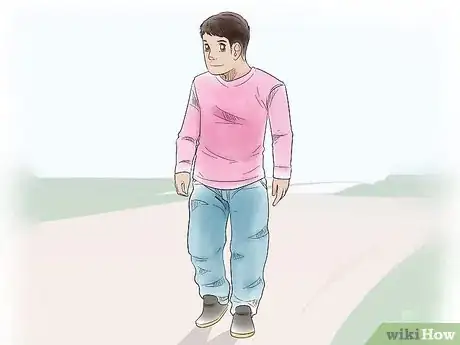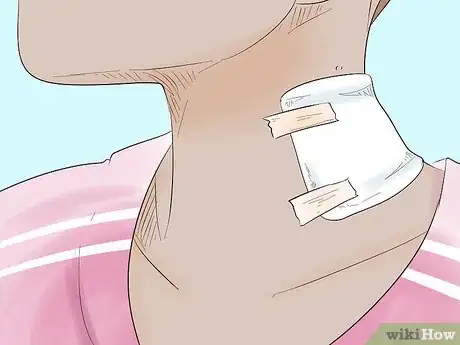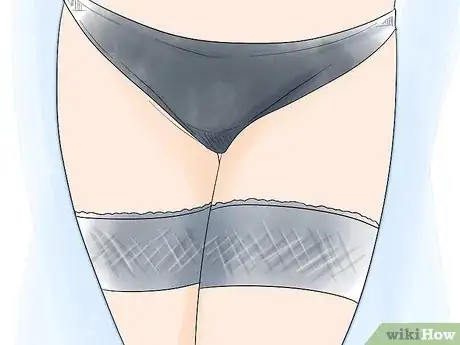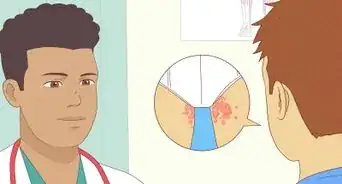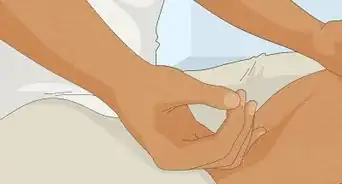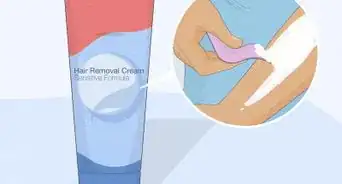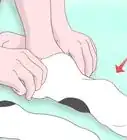This article was medically reviewed by Sarah Gehrke, RN, MS. Sarah Gehrke is a Registered Nurse and Licensed Massage Therapist in Texas. Sarah has over 10 years of experience teaching and practicing phlebotomy and intravenous (IV) therapy using physical, psychological, and emotional support. She received her Massage Therapist License from the Amarillo Massage Therapy Institute in 2008 and a M.S. in Nursing from the University of Phoenix in 2013.
This article has been viewed 68,911 times.
Chafing occurs when your skin gets too moist or rubs against another surface. If you have chafing wounds, wash them and apply a lubricant. If the chafed area is painful, swollen, bleeding, or crusted, then you may need an antibacterial cream to prevent infection. As you are healing, stay hydrated and wear loose clothing that won’t stick to the wounds. To prevent chafing in the future, you might try applying body powder or anti-chafing creams to problem areas.
Steps
Healing any Wounds
-
1Warm with warm water and mild soap. If the chafed skin is torn or bleeding, there is a possibility that it could get infected with harmful bacteria. Gently pour warm water over the skin and apply a mild soap. Keep rinsing until all of the soap is gone. Carefully pat your skin dry with a towel.[1]
- Don’t scrub or rub the chafed skin or you may worsen the damage. Your goal is not to smooth out the skin right now, it’s to cleanse it.
-
2Apply a warm compress. Now that your skin is clean and free of debris, get a clean hand towel and soak it in warm water. Wring it out and place it on the irritated skin. Let it sit until it grows cold. Re-wet it again, if you are still in pain. The heat will help to increase blood flow to the area and reduce inflammation.Advertisement
-
3Rub in a lubricant or cream. Once your skin is dry, place a small amount of lubricant or cream onto your fingertips. Slowly work this lubricant or cream into your chafed skin, rubbing in tiny circles. Apply enough product so that the entire damaged skin is covered. This will help promote healing.[2]
- Apply the cream again at least once daily, until the chafed skin is no longer open or raw.
- If your chafed skin is red, swollen, or crusted, apply an antibacterial cream to prevent or treat the infection.
-
4Give your skin time to heal. For the next few days, it’s best to minimize any activities that might further irritate that patch of chafed skin. If you have a saddle sore, skip biking for a bit. If you have a thigh burn, try to minimize walking long distances. If a certain piece of clothing is causing the chafing, such as a particular swimsuit, skip that suit and go with another one.
-
5Talk with your doctor. If the skin remains red and irritated for more than a week, you may want to contact your doctor for an appointment or advice. It is possible that you might have an infection that could be treated with oral medications or a medicated cream.
Promoting Fast Healing
-
1Drink lots of water. Your body needs water to kick-start the healing process. As you are recovering from a chafing wound, it’s even more important that you drink at least 8 glasses of water each day. If you exercise or do other strenuous activity, then you may need to drink even more to recover.[3]
-
2Bathe in Epsom salts. Run a nice, cold bath. Pour in 2 cups of salts and wait for them to fully dissolve. Sit in the bath for around 15 minutes. The salts will help to clean and dry out your chafing wounds. They will also help you to relax and take your mind off the pain.
-
3Wear loose, cotton clothing. A breathable fabric, such as cotton, will allow your skin to get enough air to stay dry and heal. Cotton also does not hold moisture against your skin, which will limit bacterial growth. You’ll want your clothing to be loose, so that it won’t stick to any injured areas.[4]
- For example, instead of wearing a synthetic-fabric nightgown, try out cotton pajamas.
-
4Keep your skin dry. If you notice that your skin is chafing and moist, get a towel and gently pat it dry. This is particularly important when caring for folded areas of skin, as moisture in these areas will promote skin breakdown. You can also dry your skin by aiming a blow dryer at it.[5]
-
5Apply bandages over any open skin. If you are worried about your damaged skin chafing even further, either tape or roll a non-stick bandage over the skin. Keep the bandage fairly loose and change it every 2 hours or so. Giving your chafed skin the most air time possible is the best option, but a bandage will keep it cleaner.[6]
Avoiding Future Chafing
-
1Apply bodyglide or Vaseline. Place a small amount of these anti-chafing products onto your fingertips and rub them into any areas of possible chafing. You want to lightly coat the entire area, not heavy enough to go through fabric but not light enough to wear off quickly.[7]
- The lubricating quality of these products will provide a protective barrier over your skin. Some people also use a thin layer of antiperspirant in the same way.
-
2Dust on a coating of body powder. Get a container of body powder and gently dust it over any skin that could chafe. The powder will help to absorb any moisture coming off of your skin. It will also create a barrier between skin-to-skin contact.[8]
- However, be warned that body powder can stain and come off on clothing. This is another reason to only apply it sparingly.
-
3Wear moisture-wicking fabrics if working out. Chafing often occurs while exercising due to the rubbing sensation of skin against skin or fabric. Wearing clothing designed to pull wetness away from the skin will help to eliminate or reduce the severity of chafing. This is also a situation where tighter-fitting clothing may be better than loose cotton.[9]
-
4Wear bandelettes. These are lace or light-fabric bands that are held onto your upper thighs with elastic edges. They are meant to prevent chafing on the thigh and can usually be worn throughout the entire day.
Warnings
- Repeated, deep chafing in the same part of your skin can cause scar tissue to develop over time.⧼thumbs_response⧽
- Make sure to wash your hands thoroughly with soap and warm water before touching the chafed skin. This will reduce the possibility of spreading any infection.⧼thumbs_response⧽
References
- ↑ https://www.cdc.gov/handwashing/when-how-handwashing.html
- ↑ https://medlineplus.gov/ency/article/002034.htm
- ↑ https://kidshealth.org/en/teens/wounds.html
- ↑ https://www.aad.org/public/everyday-care/injured-skin/burns/prevent-treat-blisters
- ↑ https://medlineplus.gov/ency/article/002034.htm
- ↑ https://www.aad.org/public/everyday-care/injured-skin/burns/prevent-treat-blisters
- ↑ https://www.aad.org/public/everyday-care/injured-skin/burns/prevent-treat-blisters
- ↑ https://www.aad.org/public/everyday-care/injured-skin/burns/prevent-treat-blisters
- ↑ https://www.aad.org/public/everyday-care/injured-skin/burns/prevent-treat-blisters
About This Article
To treat chafing, start by gently washing the area with warm water and mild soap so it doesn't get infected. Then, apply a warm compress to the area, which will help with the pain and reduce inflammation. Once the compress is cold, take it off and gently rub a lubricant or cream into your chafed skin. Give your skin a few days to heal, and try to avoid any activities that will further irritate it. For more tips from our Medical co-author, like how to speed up the healing process, scroll down!

